A lower price tag, fewer tracks and a fresh commitment to fund rail improvements in north and south California are among the features that the California High-Speed Rail Authority plans to unveil in its revised business plan, rail officials told a state Senate committee Tuesday night, March 13, at a public hearing in Mountain View.
The revised plan, which the rail authority's board of directors plans to release later this month, will also emphasize what has become known as the "blended" approach for the rail system -- a design that would have the new rail system share two tracks with Caltrain along the Peninsula corridor. This design, which was proposed by state Sen. Joe Simitian, D-Palo Alto, U.S. Rep. Anna Eshoo, D-Palo Alto, and Assemblyman Rich Gordon, D-Menlo Park, a year ago, has been the subject of much debate in recent months, with many city officials along the Peninsula urging the rail authority to commit to the two-track alternative.
At Tuesday's packed hearing in the Mountain View Center for the Performing Arts, rail officials indicated that with the new business plan, they are preparing to do just that. Dan Richard, chair of the rail authority's board of directors, and Jim Hartnett, a board member, both said that the "blended" approach is central to the agency's new vision for the project. The members made these comments at a meeting hosted by Simitian, who chairs a Senate budget committee on resources, environmental protection and transportation.
Last year, rail officials resisted the "blended approach," suggesting that it would run counter to Proposition 1A, a $9.95 billion bond for the rail system that voters approved in 2008. The agency's latest environmental analysis for the major project sill refers to a four-track system, much to the consternation of officials in Palo Alto and elsewhere.
But Hartnett said Tuesday that the agency, in its revised plan, now embraces the idea of a "blended system" for both the northern and the southern sections of the San Francisco-to-Los Angeles system. Hartnett called the new emphasis on the "blended system" a "rethinking of the whole high-speed-rail approach."
"The new direction for high-speed rail is a high-speed-rail system that is dependent on its success on a blended approach both in the north and in the south," Hartnett said.
This new vision could have dramatic implications for Caltrain, which has also been adamant about scrapping the four-track design in favor of the less disruptive blended system. The new business plan, Hartnett said, would place greater emphasis on relying on existing infrastructure in what the rail authority is calling the "bookends" of the line (its northern and southern segments). Specifically, he said, it will lay out a plan for "early investment in the north and in the south that will have direct positive impact on the regional transit systems" and lay the foundation for high-speed rail.
For Caltrain, this early investment could mean getting the funding it needs for electrification -- a project that the cash-strapped agency has been planning for more than a decade. The project, which the agency sees as key to raising its ridership numbers and achieving long-term financial stability, also includes positive train controls and a new stock of electric trains. It would cost more than $1 billion, money that the agency currently does not have.
The rail authority's new vision for the rail system could change that. The authority is preparing a "memorandum of understanding" with the Metropolitan Transportation Authority (MTC) that would identify "early investment opportunities" that the authority can make in the Bay Area. Though the document is still in the works, Caltrain electrification is widely expected to top the list of the Bay Area's transit priorities.
"This is an opportunity for Caltrain as much as it is an opportunity for high-speed rail," Hartnett said, referring to the early investment. "We believe the plan will set out a reasonable way of doing that."
But even as they talked about making early investment in the "bookends," rail officials on Tuesday defended the authority's decision to begin the line's construction in the Central Valley. This decision had prompted many critics of the $98.5 billion project to refer to the system as a "train from nowhere to nowhere." Some, including the agency's own peer review group, have challenged its earlier business plan for inadequate discussion of funding sources and for its vagueness in discussing plans to build the system beyond the initial segment.
Aside from the voter-approved bond and about $3 billion in federal money, the project has no other committed funding sources. The agency's business plan anticipates private investment in the later stages of the project.
The challenge, Richard said, is to demonstrate that the first segment of the line would provide significant improvements even if the agency doesn't get the funding it needs to build the entire system. The revised business plan, he said, "will have a more rational basis for showing how the system develops over time so that each station that we'll have in front us will have something that is useful -- like Caltrain electrification, for example."
Richard, who was recently appointed to the board of directors by Gov. Jerry Brown, defended the decision to start in the Central Valley. Starting the rail system in this region will allow the agency to test the new 225 mph trains, he said. On the Peninsula, the trains would reach speeds of up to 125 mph.
Richard also said the agency believes that the new system's ridership will be sufficient to cover its operating costs. The rail authority's ridership and revenue numbers have been a subject of major criticism on the Peninsula and elsewhere. Uncertainties over these projections, along with the project's escalating costs, were among the major factors that prompted the Palo Alto City Council to officially adopt a position last year calling for the project's termination.
But Richard said that the numbers show that even in the line's "initial operating segment" (the first constructed segment that would be capable of accommodating high-speed trains), ridership would be sufficient to pay for operations.
"We believe that the ultimate ridership projections will mean that there will be sufficient riders on the high-speed rail so that we will not be needing a public subsidy in order to operate," Richard said.
Though Richard did not specify how much the rail system would cost under the "blended" approach, he said the number will come down from the prior estimate of $98.5 billion. He called the price tag (which was a major jump from the agency's prior estimate of about $40 billion), a "sticker shock" for many people. It will be incumbent for the agency to show, in its new business plan, the ways in which the capital costs can be reduced.
"The key to it is the blend approach," Richard said. "This is one of the things that will lock us into the course that I think will save us a lot of money."
Though the rail authority's new vision is more consistent with the views of many Peninsula officials, some said Tuesday that they remain skeptical about the latest plans. Palo Alto Councilman Pat Burt, who chairs the Peninsula Cities Consortium (a coalition that also includes Atherton, Menlo Park, Belmont, Burlingame and Brisbane) said that when it comes to early investment opportunities on the Peninsula, the "devil will be in the details" of the agreement between the rail authority and the MTC. He noted that the MTC signaled that cities along the Peninsula would not have any direct participation in the process.
Burlingame Councilwoman Terry Nagel also said she is concerned about the MTC's ability to adequately represent the Peninsula cities in the "eleventh hour."
"I don't think the majority of the cities are opposed to high-speed rail if it's done right -- and that's a big if," Nagel said. "It would require money that is well spent on the Peninsula."
Related story:
• Palo Alto skeptical about 'new vision' for high-speed rail
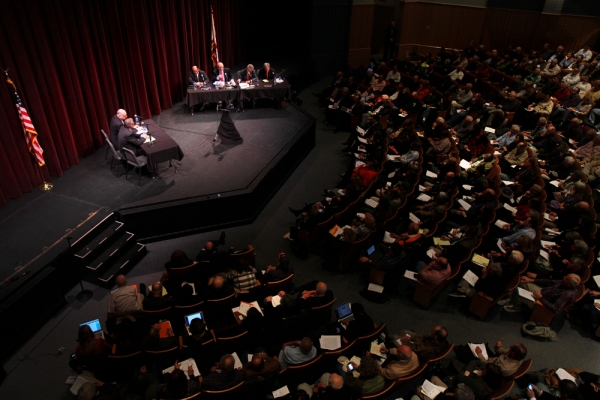
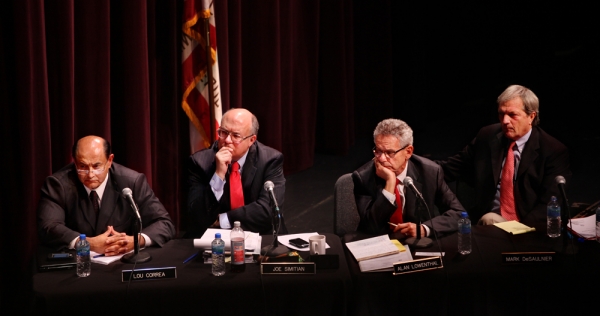
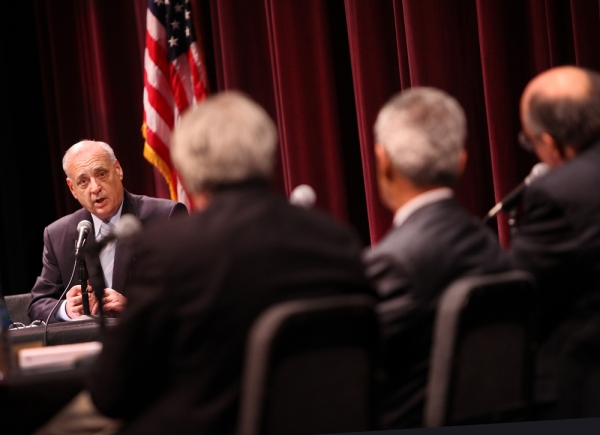
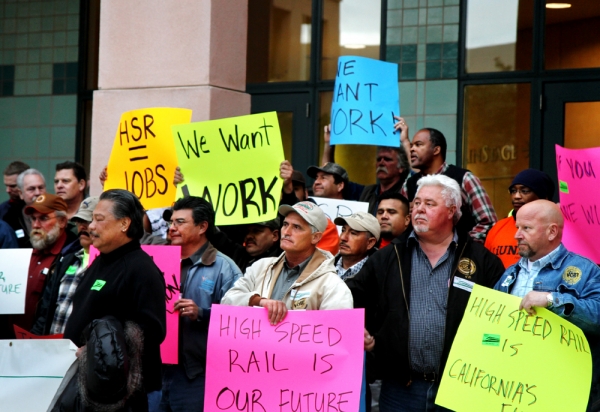

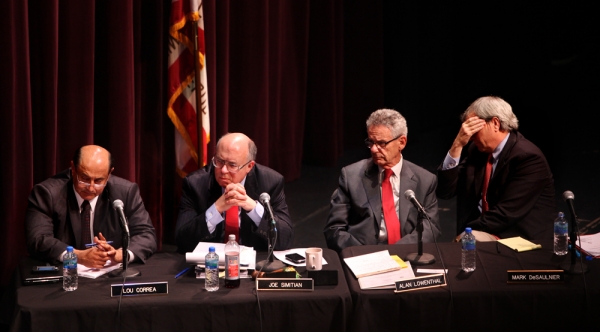


Comments
Adobe-Meadow
on Mar 14, 2012 at 10:21 am
on Mar 14, 2012 at 10:21 am
Stalling just increases the cost. Get it done now. The new plan sounds like a big improvement to both local transportation and state-wide transportation. Costs are going down as more planning gets done. Get it done now before inflation and rising property values drive up the cost.
Midtown
on Mar 14, 2012 at 10:36 am
on Mar 14, 2012 at 10:36 am
HSR is dead in California...for now.
It is time to just count our losses and move on to other things. It would be great if this commission would STOP SPENDING $$$ since they are fully aware that this is dead.
Mountain View
on Mar 14, 2012 at 10:43 am
on Mar 14, 2012 at 10:43 am
So Palo Alto, Menlo Park, Atherton, get two tracks while Mountain View and Sunnyvale and cities to the north like Milbrae get the four tracks for passing. Now I see how this works. The more affluent neighborhoods get their way. Typical.
Professorville
on Mar 14, 2012 at 10:47 am
on Mar 14, 2012 at 10:47 am
CREDIBILITY has become the big problem for the High-Speed Rail Authority; HSR has none.
Why would anyone believe a word they say? On virtually every substantive issue, HSR has been wrong, wrong, wrong. Let us count the ways:
• NONE of the promises made to barely win 2008 1A vote are being kept…
o No more than $40 billion to connect San Diego, Los Angeles, Sacramento and San Francisco
o No more than $9.95 billion from state of California
o No money authorized until investors committed
o Los Angeles to San Francisco for about $50
o Los Angeles to San Francisco in 2½ hours
o Ridership forecast ridiculously high
• BOGUS HSR plans, independent auditors say
o Peer Review Group January 3, 2012
o Legislative Analyst Office November 29, 2011
o State Inspector General October 27, 2010
o California State Auditor April 2010 Report 2009-106
o Joseph Vranich October 2008
Any village idiot can connect the dots on this one, yet Simitian, Eshoo, Brown, et al seem unable to do so. Quite the opposite. Until they connect the obvious dots, my future votes will be for someone else.
'Fool me once, shame on you. Fool me twice, shame on me.'
Registered user
Ventura
on Mar 14, 2012 at 10:47 am
Registered user
on Mar 14, 2012 at 10:47 am
This is a big step in the right direction. The same dollars benefit both Caltrain and HSR.
Caltrain still needs a permanent source of funding - and all of the at grade level crossings will need to be replaced with grade separated crossings but this could be done in a less disruptive manner.
Southgate
on Mar 14, 2012 at 11:29 am
on Mar 14, 2012 at 11:29 am
So, the 'blended' track well help Caltrain? There is no answer to how these tracks will run...above ground, underground or at ground! We all know that below ground is expensive and since they are cutting expenses that will go!
I so agree with Paul and how can we get this through to the rest of the state?? There is no money anywhere!!
Another Palo Alto neighborhood
on Mar 14, 2012 at 12:14 pm
on Mar 14, 2012 at 12:14 pm
> Caltrain still needs a permanent source of funding
Well .. it could charge its riders the true cost of the system's capital and operations--rather than expecting the people who don't use the system to pay for this massive boondoggle.
Registered user
Community Center
on Mar 14, 2012 at 12:32 pm
Registered user
on Mar 14, 2012 at 12:32 pm
I like Joe, and I must him give him credit for vetting the High Speed Rail concept almost to a fault. Hearing after hearing, town meeting after town meeting.
Enough is enough.
I went to the hearing Tuesday, March 13, at the MV performing arts center. The place was SRO, absolutely packed. Clearly there is a great deal of passion about this matter, no matter what point of view one has.
I heard nothing last night that changed my mind that this is a bad idea. Lots of “polishing” you know what.
For starters, it appears that the very civil new management for CHSRA, including Dan Richard, have a very different point of view about how this thing should/could be built out than does the very civil Mr. Kempton, from the High Speed Rail Peer Review Group.
One wants to start in the Central Valley with track to nowhere, lacking HSR capability. The other advocates first making improvements at the “bookends” of LA and the Bay Area. Talk about a huge disconnect.
There remain huge questions about funding, which were for the most part artfully dodged, with allusions to days gone by about how the UC system was developed, the interstate highway system came about, inter alia. The fact is at best 15% of the cost of the $98 billion proposal has been identified.
To make matters worse, it appears that some of the available federal funds only will be available only if they are applied to an HSR spur in the Central Valley. Those funds, if I correctly understood last night’s testimony, cannot be used for improvements at the “bookends” of NORCAL and SOCAL. Is CHSRA advocating a central valley place to start just so they can get the federal funds? It sure looked that way to me in last night’s hearings.
My closing observation about this entire matter is that too many people in responsible positions continue struggling to somehow squeeze life out of this ill-conceived project. (e.g., the mantra “blended system” has been bandied about for months now, and it was not made clear at this hearing how it will “really” work.)
This is a project that has gotten more second chances that most of us get in a lifetime. Try and try, it continues to not pass muster. Voters were mis-led in the 2008 ballot initiative, clearly a “bait and switch.”
Get it back on the ballot, and it will go down in flames. (I suppose that is a bad analogy, since it alludes to aircraft. How about get it back on the ballot, and it will be off the rails!)
CHSRA releases a revised business plan in the coming weeks, ostensibly an improvement over prior plans by prior “regimes.”
Rather than taking it to the State Capitol for review, I suggest they try out their pitch on Sand Hill Road, with the venture capital community. They may as a courtesy get a first pitch meeting. There never will be a second meeting, let alone private funding participation in this beast.
Old Palo Alto
on Mar 14, 2012 at 1:32 pm
on Mar 14, 2012 at 1:32 pm
HSR, HSR, HSR! we need it
College Terrace
on Mar 14, 2012 at 1:47 pm
on Mar 14, 2012 at 1:47 pm
"Get it back on the ballot, and it will go down..." I agree.
Paul, have you signed the petition yet?
Web Link
Downtown North
on Mar 14, 2012 at 10:03 pm
on Mar 14, 2012 at 10:03 pm
$100 Billion to build it.
$100 Billion in interest payments.
$100 Billion to operate it.
I believe these costs are to spread out over a 30 year period.
$10 Billion/year drained from the CA treasury.
Where is all that money coming from? The Feds? probably not. All those secret private investors? What investors? The billion in profits promised in Prop 1A! Who were they kidding?
What do you want to give up for High Speed Rail? Schools, improvements to real infrastructure, improving local mass transit where people really need it, and the list goes on. Our "leaders" in Sacramento should be ashamed of themselves.
Barron Park
on Mar 14, 2012 at 10:11 pm
on Mar 14, 2012 at 10:11 pm
Why do they keep trying o force this on us. We don't want it.
Spend the money on the schools.
another community
on Mar 15, 2012 at 12:39 pm
on Mar 15, 2012 at 12:39 pm
Gus ------"WE (???) don't want it."
60% of the electorate, including ME, do want it. Majority rules in this country. Sometimes we like it, sometimes we don't.
I lived with Bush Jr. for 8 long years....bummer for me, but it's still a democracy and I'm all for that.
Crescent Park
on Mar 15, 2012 at 1:50 pm
on Mar 15, 2012 at 1:50 pm
60% of a low turn out, not 60% of the "electorate". The word electorate refers to the entire number of people eligible to vote, not to those who chose to vote on a certain day.
Put it to a vote today, with all of the new numbers and the fact that a not single private investor is willing to even sniff this boondoggle. A very different outcome is likely.
College Terrace
on Mar 15, 2012 at 2:02 pm
on Mar 15, 2012 at 2:02 pm
"Put it to a vote today"
Dad,
Have you signed the petition? Be part of a real old-fashioned grass roots effort, if you want to. Imagine such an effort that does not require mega-bucks to get on the ballot? Just takes some individual efforts.
Web Link
Old Palo Alto
on Mar 16, 2012 at 12:37 am
on Mar 16, 2012 at 12:37 am
Another con job from the CAHSRA. How many times and how many ways are they going to keep reinventing this thing?
Midtown
on Mar 16, 2012 at 8:36 am
on Mar 16, 2012 at 8:36 am
You can almost fund NASA with this same budget. Go figure.
another community
on Mar 16, 2012 at 9:18 am
on Mar 16, 2012 at 9:18 am
Crescent Park Dad
Your "Low turnout" argument doesn't work -- we can't take back every election you don't like with claims of low turn out.
Regrettably, lots of folks don't vote, but every measure that passed/failed in a fair election is not up for reconsideration. Otherwise, we may have had President Gore --- not to mention many simple public works projects we now take for granted.
However, there is a repeal process -- and you are welcome to try to convince the rest of the state that the the benefits of the rail project (jobs, connectivity -- even subsized) are actually a public good that is outweighed by the needs of some citizens of well-to-do Palo Alto who have property near the right of way.
While election voters in Palo Alto may have had a local majority against the rail measure that passed (and even that is an empirical question), the state voters passed the measure. Palo Alto doesn't get to say no, but it can negotiate details in the project instead of taking the simple NIMBY argument.
Midtown
on Mar 16, 2012 at 11:36 am
on Mar 16, 2012 at 11:36 am
neighbor, a resident of another community,
The ballot that was passed had restrictions on releasing the bond money for building HSR - it has to make the trip in roughly 2 hours, no subsidy from the government for operational costs, the system to cost no more than $43 billion to build, the system to be operation in 2020, and funding for the remaining $33 billion to be in place.
Not one of these restrictions has been met - so your name calling of "NIMBY" is rather misplaced. HSR is not meeting it's commitments, it's just as simple as that.
Menlo Park
on Mar 16, 2012 at 7:57 pm
on Mar 16, 2012 at 7:57 pm
I think I must have misunderstood the Blended plan??
This is a stopgap plan to use Caltrain tracks, knowing that at a later date the intention is to build on the peninsula the new high-speed rail track. Excuse me, but I find this absurd. Have I missed something? If there is a high speed train on the tracks, any track, any contact with the public must be absolutely avoided. Would they not have to build “grade crossings” at every street crossing the tracks?
To build them only for one set of tracks, and then later redo each crossing to accommodate the eventual plan of a second set is a no-brainer! So the destruction of existing businesses, structures, etc. at each crossing would be the same even if high-speed rail could use the old Caltrain tracks, which seems unlikely to me.
As for the double set of tracks eventually planned...
I wonder if the high-speed rail enthusiasts factored in the COST of taking down thousands of old growth trees, probably including the old Palo Alto redwood grove along the tracks. (I remember what it cost to take out a single Monterey pine on our property a few years ago!) And the cost of the certain demolition of many long-established businesses, office buildings, maybe the Stanford Park Hotel, apartment houses, railway stations along the Peninsula, reimbursement to the owners and communities affected, not to mention private homes which will be lost!
Did they ever decide if they would build the new tracks on the East or West side of the Caltrain tracks?
And how to manage the redirection of traffic now using the major arteries affected – Alma Street and the Central Expressway
Another Palo Alto neighborhood
on Mar 17, 2012 at 1:32 pm
on Mar 17, 2012 at 1:32 pm
@Kay, their latest plans call for closing 2 lanes of Alma from about Homer to Oregon.
Crescent Park
on Mar 17, 2012 at 4:32 pm
on Mar 17, 2012 at 4:32 pm
Not disagreeing on a certified election. Just pointing out that it was 60% of the vote taken, not of the entire population eligible to vote as claimed.
I don't live by the tracks. But this project is completely out of control budget-wise. The people who voted for this project did not vote for the current estimated costs. Even the HSR honks admit that the budget has tripled and will probably go higher.
How can any of the HSR supporters continue to ignore the astronomical costs and the fact no one from the private sector is willing to invest?
Old Palo Alto
on Mar 17, 2012 at 6:24 pm
on Mar 17, 2012 at 6:24 pm
So the naysayers in 3 affluent peninsula burgs are hanging the initial concept from High Speed Rail to Low Speed Rail, with their selfish and self righteous, me first, "I am better than you" attitude. From Mountain View all the way to Southern California no city made a stink about High Speed Rail (4 Tracks), to their credit they have the vision for the common good and the long term picture of mass transportation; what a contrast with the elitist snooty naysayers in the little towns of Palo Alto, Atherton and the other sorry burg demanding the reduction from 4 tracks(needed for a true HSR) to only the existing 2 tracks that must be shared with a Neanderthal train system(CALTRAIN), so they came up with their "blended" system, credit their parasite representative living in the State Legislature for this.
They really think they are better than the rest of the State of California.
Another Palo Alto neighborhood
on Mar 17, 2012 at 9:45 pm
on Mar 17, 2012 at 9:45 pm
@Carlitos: you're wrong about how many cities are "making a stink". There are more than 3 cities on the peninsula who are against the project. They are joined by entire counties in the Central Valley, and more cities in southern California. This has nothing to do with snootiness, elitism, or even naysayerism. It does have to do with education, though. The more people know about the project, the more they are against it.
At least 4 polls came out with similar results: people want a chance to revote, and given that chance, a majority of voters would vote 'no'.
Fairmeadow
on Jun 7, 2012 at 7:39 pm
on Jun 7, 2012 at 7:39 pm
It's too funny!
4 years after the vote. New business plan! No wait a newer business plan. No wait a newer newer business plan. No wait a newer newer newer newer business plan.
Can't be done for what was promised. Scrap it.
But where will termed out politicians go for handouts and consultant fees?